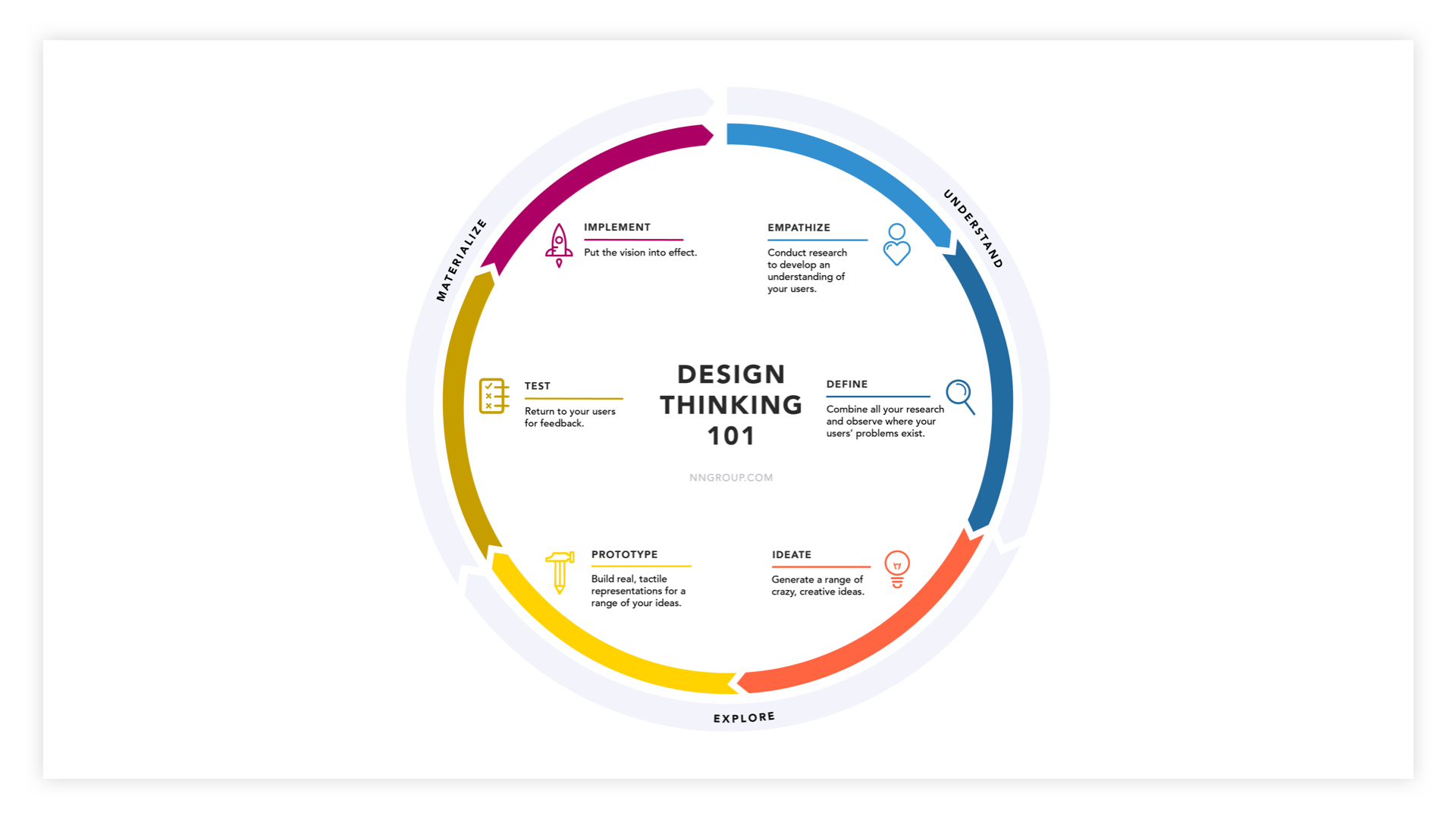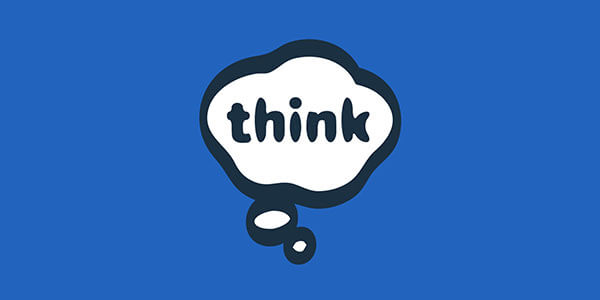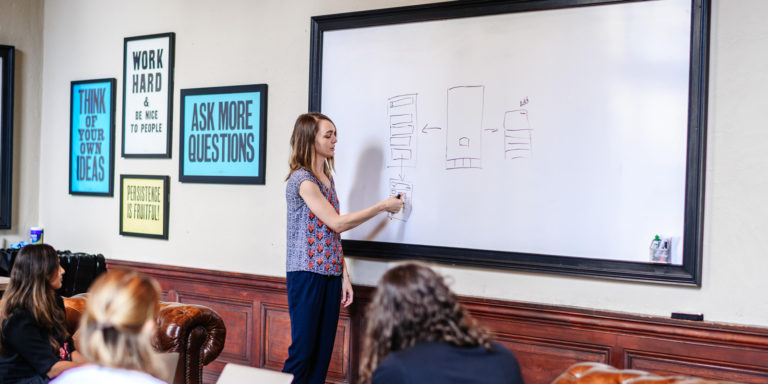Design and Technology Guides
Understanding design thinking: A beginner’s guide
At Think Company, design thinking is at the core of nearly everything we do. This approach and process helps us solve complex problems and powers our ability to find actionable goals and sustainable solutions.
We’ve put together this beginners’ guide to design thinking to share how our teams use it and to empower you to take advantage of its benefits for yourself. If you’re new to design thinking—or want to get a greater sense of how you can implement its principles for better business outcomes—you’re in the right place.

What is design thinking?
Design thinking can be challenging to define. It’s often described as a combination of a strategy, a method, and a worldview. At Think Company, we use design thinking as an approach for practical and creative problem-solving.
Design thinking is all about creating innovative solutions with the user at the center, which involves turning ideas into tangible things that can be tested and improved. This human-centered approach translates to impactful and dynamic solutions that evolve with the user.
How do UX and design thinking work together?
User experience (UX) design and design thinking are both centered around the user and built on empathy, so many people think they’re the same thing. The reality is that they’re two distinct processes, and they work together beautifully.
UX design lives “close to the ground” in the practical implementation of designs and ideas; design thinking often lives higher up the mountain at the strategic level. Design thinking invites practitioners to explore a problem conceptually, incorporating user needs, technical feasibility, and industry best practices to form a solution.
In other words, design thinking focuses on finding solutions, while UX design is the practical creation and implementation of these solutions.
Why is design thinking important?
Since the term “design thinking” was coined in 1969, organizations have utilized its principles to solve big and small problems across many industries. Our teams use the design thinking process to center the user in the solutions we create and help us innovate to serve the user. Design thinking helps our teams research, prototype, and test solutions to reveal new and effective ways to meet users’ needs.
The importance of design thinking in our processes can’t be understated. Designing without centering on the user’s needs and pain points results in static and inflexible products that aren’t sustainable solutions for the user or the organization. With design thinking, teams are empowered to think bigger and generate new and often unexpected ideas. Design thinking creates an opportunity to access unique insights and create dynamic and effective solutions with exciting iterative possibilities.
The 6 steps of the design thinking process
As we’ve talked about, design thinking is both an ideology and a process. The design thinking process is a sequence of six distinct steps that guide our teams through problem-solving and help us maintain focus on the user.
The six steps of the design thinking process can stand alone, but work best when utilized together. The stages of design thinking, however, aren’t necessarily always run sequentially. Our teams often run different elements at the same time or repeat certain phases iteratively.

Image: Nielsen Norman
1. Empathize
The first natural step in design thinking is empathizing with the user. Practically, this looks like conducting research to develop knowledge about what your users do, say, think, and feel. Empathy maps are often developed in this phase to create a shared understanding of user needs.
2. Define
Once you have a more definite sense of your user’s needs, the “define” stage invites you to examine and analyze them. Defining users’ needs sets the stage for addressing and resolving those needs.
3. Ideate
After uncovering and defining your users’ needs, the next step is ideation, or finding solutions to those needs. This is often a very creative, abstract part of the process where it can be helpful to “go big” with your ideas and play with unique solutions.
4. Prototype
Once you’ve identified potential solutions to your users’ unmet needs, it’s time to narrow the field to the most practical, exciting ideas. By building prototypes of these concepts, you can see how useful they are and understand how they function for your users.
5. Test
Prototypes require testing. By asking real users to test your designs, you can access data about users’ experience of your ideas. If your prototypes perform well, it’s time to move to implementation. But if your ideas aren’t resonating with users, this is an excellent time to go back to the ideation phase.
6. Implement
If your testing phase has shown that your ideas are real solutions for users, it’s time to bring the vision fully to life. Implementing the concept puts it to work in the real world for a broader range of users, where you can continue tracking its effectiveness over time.
Design thinking tools
To implement UX design thinking, you’ll need more than a room of designers, stakeholders, and users discussing improvements and ideas. Each step in the design thinking process is grounded in research, design, and development, and because of that, we recommend a handful of helpful tools.
Centiment, Survey Monkey, Typeform, Zoom Cloud Recording, Otter.ai Transcription
Empathize
When it comes to understanding your users better, we like implementing a multi-faceted approach, conducting IDIs (in-depth interviews), focus groups, contextual inquiries, and surveys. Video conferencing tools like Zoom Cloud Recording and transcript tools like Otter.ai help ensure we can go back into the interview or focus group conversation and analyze deeper (or include more researchers who weren’t present). Importantly, outside of tooling, assigning a notetaker to each session allows us to capture key details and quickly review them instead of reading through an entire transcript. When resources don’t allow for individual interviews and focus groups or we’re looking at larger audiences capturing feedback and sentiment via survey tools allows us to carefully craft our user research questions and collect user data via Likert Scale questionnaires.
Lookback.io, Maze, Userttesting.com, OptimalWorkshop (Chalkmark)
Empathize, Define
These user testing tools allow participants to click through prototypes so we can see the path and experience they’re taking when using a product, bringing them one step closer to the actual experience. They offer screen recording to watch users’ movements, clicks, etc., and audio recording, which is helpful when making prompts for the user and gathering their feedback after completing a task.
Figjam, Miro
Empathize, Define, Ideate
Utilizing the whiteboarding features of these tools allows you to conduct research engagements like affinity mapping, gamification of research, sailboat exercises, etc. From there, you can synthesize findings, define areas of improvement, and ideate solutions (even mapping out the next steps). Our team relies on these tools heavily when synthesizing and organizing findings into categories and uncovering trends that will inform our design decisions.
Figma
Ideate, Prototype
This powerful collaborative design tool allows designers to collaborate on design ideation and production in one place. Its capabilities enable designers to create shareable assets and styles that are accessible to the whole team. Our designers work through ideation, design, and prototyping all in one place.
Storybook
Prototype, Test, Implement
A favorite of the Think team, this tool allows designers and developers to collaborate in real time. An open-source tool for building UI components and prototypes—Storybook makes it easy for developers to modularize full sites based on Figma designs allowing users to experience a clickable prototype and streamlining the build process from prototype and testing to implementation.
HotJar, UserTesting
Test
These tools allow you to collect data about how a user moves through your product/site. Heatmaps show where they’re clicking, spending more time, not reaching, etc., on a page. They allow for the creation and implementation of intercept surveys or questionnaires that can appear in the live environment enabling you to meet the user where they are and capture real-time feedback. These testing tools are an effective way to learn from users because insights are captured while users are engaging in the actual experience. This data can help ensure the changes that were made are improving the user’s experience and working in the way they were designed to.
Design thinking with agile
Design thinking and agile can be seen as separate approaches, with teams forcing a decision between design thinking vs. agile. But there’s no need to silo the methods—these processes can work together to support practical problem-solving.
Applying design thinking in an agile environment helps create a product development process that is both efficient and user-centered. Teams who utilize design thinking to generate innovative solutions to solve user problems can apply those changes with short agile sprints. These short sprint cycles create a process that is dynamic and adaptable as things change throughout the project.
Benefits of design thinking
Now that we’ve gone over how design thinking is used and implemented, it’s time to talk about how it practically benefits teams (and their users):
- Drives innovation – Design thinking is all about challenging assumptions and established beliefs, encouraging all stakeholders to think outside the box. This fosters a culture of innovation that extends well beyond the design team.
- Creates dynamic products – When your users are at the center of the creation process, the products that result are dynamic and flexible. Rather than being bulky and quickly outgrown, these products evolve as your customers evolve.
- Reduces time-to-market – Since users’ actual needs are driving the creative process, design thinking generates practical and needed solutions. Design thinking can significantly reduce the time spent on design and development—especially when utilized in an agile environment.
- Improves customer retention and loyalty – It may be obvious, but creating user-centered products means that your customers find them more helpful and fun to use. This translates to a customer base that relies more and more on your product, so they keep coming back.
Whether you’re establishing a Design Thinking culture on a company-wide scale or simply trying to improve your approach to user-centric design, Design Thinking will help you innovate, focus on the user, and ultimately design products that solve real user problems.
Putting design thinking into practice
At Think Company, design thinking helps us work through problems and guides us in searching for actionable goals and sustainable solutions. We’ve seen design thinking streamline the product creation timeline and lead our teams to meaningful, creative solutions that meet real user needs. Products designed this way are dynamic and engaging because they’re built with the user in mind. Is it time for your team to start implementing design thinking principles?.
Want to see more?


